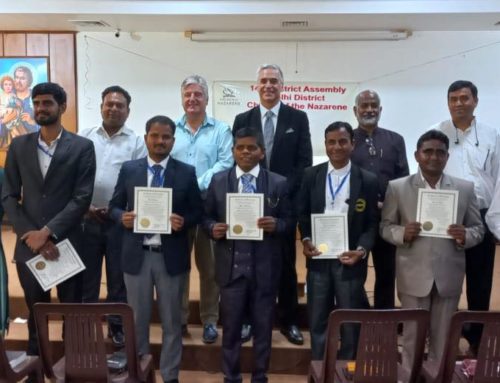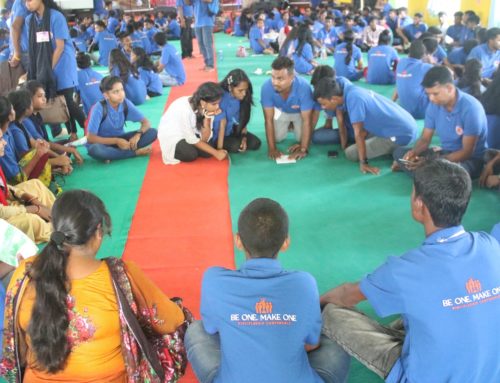Jerusalem – Many poor around the world struggle to feed their families in arid climates or during droughts or floods. But what about those families in urban areas who don’t even have land to call their own?
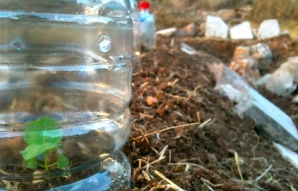 In the Middle East, Nazarenes are attempting to turn rooftops into productive gardens.
In the Middle East, Nazarenes are attempting to turn rooftops into productive gardens.
The aim of this research is to see if a system that is both affordable and sustainable could be designed to produce adequate fruit and vegetable yields on household rooftops in the Middle East, in refugee camps and poor urban areas, as well as other less fertile areas in the world.
Given the reduced access to water and green spaces in over-populated urban areas of the Middle East, an aquaponics system has numerous benefits. It could bolster poorer families’ access to a wider variety of nutritional foods and contribute towards food self-sufficiency. It may also reduce the household expenditures on fresh produce. In addition it conserves water due to recycling, uses land efficiently and reduces the environmental footprint for crop production.
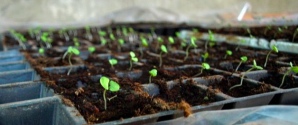 This project is supported by Nazarene Compassionate Ministries (NCM); the Church of the Nazarene in Jerusalem; Tearfund Ireland, an independent relief and development charitable agency; and The Leprosy Mission (TLM) Ireland, a charity that works closely with its partners to deliver holistic community development aid, emergency and disaster relief. TLM Ireland and Tearfund Ireland work in some of the poorest and most marginalised places in the world. The groups are interested in seeing if aquaponic food production is a viable method for poorer families to become more self-sufficient.
This project is supported by Nazarene Compassionate Ministries (NCM); the Church of the Nazarene in Jerusalem; Tearfund Ireland, an independent relief and development charitable agency; and The Leprosy Mission (TLM) Ireland, a charity that works closely with its partners to deliver holistic community development aid, emergency and disaster relief. TLM Ireland and Tearfund Ireland work in some of the poorest and most marginalised places in the world. The groups are interested in seeing if aquaponic food production is a viable method for poorer families to become more self-sufficient.
Evans said the team will try to develop a system that can withstand the environmental constraints, and at the same time consult with surrounding communities to better understand their need and gauge their interest. Like any good development intervention, this is an endeavour that will very much rely on the innovation of the local people with a passion to make it work. As such, the final shape of such a project is undecided.
Earlier this year, Petrie and Somerville volunteered with an environmental project in the Middle East; Evans was working for a humanitarian organization in Central Asia. When they returned to Ireland in April, they started thinking of a response to people’s limited access to water and the lack of land suitable for farming. Petrie kick-started the process by building a small aquaponics system consisting of four tomato plants and five goldfish.
At the same time, Lindell Browning, field strategy coordinator of the Eastern Mediterranean, asked Evans if he could help lead the local church in Jerusalem while Philip Rhodebush, the church team leader and facilitator, was on deputation. Evans agreed, asking if he could bring Petrie and Somerville to trial aquaponics systems on the roof.
In May, they built three small aquaponics systems in Dublin, Ireland, running a trial where they grew lettuce, tomatoes, peppers, basil, chives, strawberries – to name a few. They then began to consult with TLM, NCM, Tearfund Ireland and the church in Jerusalem to assess the viability of doing comprehensive research in this area.
There are now 16 aquaponics systems on the Jerusalem church roof.
“As a Christian Arab, I have never seen anything like this,” said Jeries, a resident of the Old City in Jerusalem and member of the local Nazarene church. “I was so impressed to have this kind of project in my home country.”
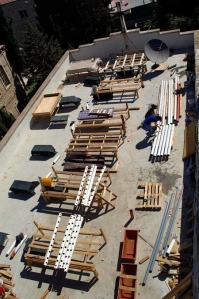 Aquaponics is an existing technology but it has mostly been used on large-scale commercial levels. Their interest is seeing this work in a humanitarian setting, through the reuse of scrap materials.
Aquaponics is an existing technology but it has mostly been used on large-scale commercial levels. Their interest is seeing this work in a humanitarian setting, through the reuse of scrap materials.
Browning said his hope is that families with no land or income will be able to use their small rooftops or balconies to grow healthy food for their family.
“The aquaponics project is something very new to me,” he said. “It has taken a lot of dedication and hard work but now seeing the vegetables starting to grow, it is exciting. I see it as testimony of people who care about their neighbours. I hope they will know that the church is supporting this project for their sake and know we care about their daily needs, not only spiritual needs.”
Evans, Petrie and Somerville are now living at the church, helping organize services, leading music and getting involved in congregation life. The church is an English-speaking group consisting of both locals and internationals.
“It has been an interesting process to take a project like this from a garden in south Dublin all the way to the rooftop of a church in the heart of Jerusalem,” said Petrie. “It has come with its challenges and also its rewards. It’s been encouraging to meet local people here so enthusiastic about what we’re doing.”
“This has generated a lot of interest in the wider community, and we are hopeful that this could genuinely help poorer families to improve their daily diet, as well as provide enjoyment and satisfaction in moving toward self-sufficiency,” said Evans. “In a part of the world where the urban poor and refugee communities do not enjoy many freedoms, there is significance in growing your own food and exhibiting more control in day-to-day life. We are very excited about the potential and are grateful for the support of the church and our other partners.”
According to Browning, the project has already created exposure and interest in the church. Since the project is on the church rooftop, merchants from whom supplies have been purchased and people who have heard of the project stop at the church frequently to see it.
“It demonstrates a caring people who want to meet practical needs of people. Other groups have indicated they might want to partner with us to reach larger groups of people,” said Browning.
For more information on the Aquaponics project, please visit their Facebook page: “Aquaponics Research” or contact rooftopaquaponic@gmail.com.
What is Aquaponics?
- The waste from fish is treated with natural bacteria, converting the waste into an organic nutrient solution for the growing plants.
- As the plants soak up the nutrients in the water, the water is purified before flowing back into the fish tank.
- Both systems are mutually beneficial and no chemicals or fertilizers are used at any stage, reducing the overall cost to the environment and the financial cost for small growers.
- Aquaponics requires only a fraction of the water needed for ground-grown plant production, making it an ideal system for water-scarce urban areas. The only regular input to the system is food for the fish.
{loadposition user2}


